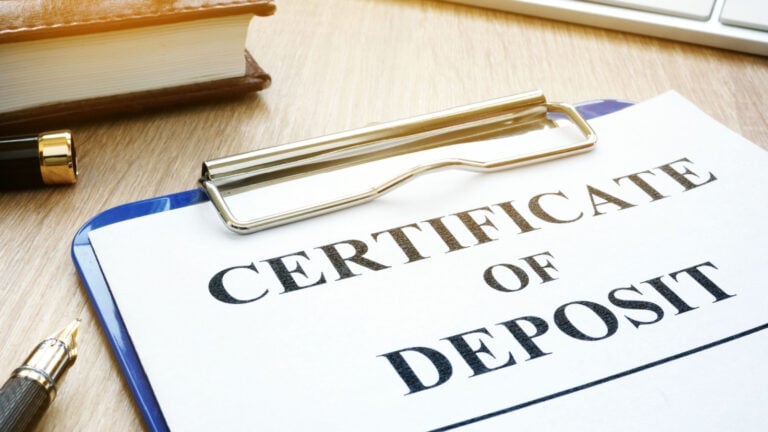Editorial Note: InvestorPlace Beacon independently determines what we cover and recommend. We earn a commission from affiliate partners on many offers and links. However, these commissions do not affect our editors' opinions or evaluations. Click here to read our full advertiser disclosure.

Source: Shutterstock
Those looking for a low-risk investment product could consider adding a certificate of deposit (CD) to their portfolio. CDs are customizable and easy to open at most banks and credit unions. Use our comprehensive CD guide to understand how they work, who they’re best suited for and how to maximize your savings.
What Is a CD?
A CD is a secure financial product that earns interest on your deposit for a predetermined time period. Banks and credit unions offer CDs, though credit unions typically call them “share certificates.”
Once funds are placed in the CD, you typically cannot withdraw them without facing a penalty. The time period in which you cannot touch the money is called the CD’s “term.” CD term lengths are typically between three months and five years. Once the term is up, your initial deposit and the interest you’ve earned is returned to you.
Almost all CDs are insured by the Federal Deposit Insurance Corporation (FDIC) or National Credit Union Administration (NCUA) for up to $250,000, meaning that if the bank or credit union you open your CD with collapses, your money is protected. This makes CDs a particularly secure investment product.
CDs earn higher interest rates than traditional savings accounts and money market accounts due to their lack of liquidity.
| Did you know? |
| In 2024, the best CD rates are around 5%. Meanwhile, the national average rate for a traditional savings account is only 0.47%, according to the FDIC. |
It’s important to note that there are different types of CDs, and their features and rules vary.
Types of CDs
Each type of CD has slightly different rates and customization features. Carefully consider each type of CD to determine which meets your risk tolerance and savings goals.
9 Common CD Types
- Traditional CDs
- A traditional CD usually requires a minimum deposit of at least $500. The amount in your CD, interest rate and CD term are fixed. If you tap into your funds before the term is over, you face a penalty.
- No-Penalty CD
- With a no-penalty CD, you won’t face a penalty if you tap into your funds before the CD term is over. However, because there’s lower risk, expect the interest rate to be lower compared to a traditional CD. They also tend to have shorter rates than traditional CDs, which means you lock in your interest rate for less time.
- Add-on CD
- Unlike a traditional CD, an add-on CD allows you to contribute money to your CD throughout the term. This flexibility could mean a lower rate compared to traditional CDs.
- Callable CD
- With a callable CD, the bank has the right to “call back” your CD before the term is up. If your CD is called back the bank will return your initial deposit, along with the interest you’ve earned so far. Because a callable CD is riskier, they usually have higher interest rates than traditional CDs. Only the issuer can call back the CD, meaning that if you decide to withdraw early, you’ll likely face a penalty as you would with a traditional CD.
- Jumbo CD
- A jumbo CD requires a large deposit, usually of $100,000 or more, in exchange for a higher interest rate than a traditional CD. Otherwise, they generally follow the same rules as a traditional CD.
- Bump-up CD
- With a bump-up CD, you’re allowed to request a higher rate during your term, which can come in handy if the Federal Reserve’s benchmark interest rate increases. This type usually has a slightly lower rate than traditional CDs.
- Step-up CD
- Step-up CDs automatically raise your interest rate according to a set schedule. Similar to the bump-up CD, this typically results in a lower interest rate than those on traditional CDs.
- IRA CD
- You can open a CD within an individual retirement account (IRA), which comes with tax advantages. IRA CDs earn similar rates compared to a traditional CD. Keep in mind that when investing in IRA CDs, you need to follow the IRS’ contribution limits and withdrawal tax rules that apply to IRAs
- Brokered CD
- A brokered CD is similar to a traditional CD, except it’s purchased from a broker on the secondary market, instead of a bank. Rates for brokered CDs are usually higher than traditional CDs, but brokered CDs can also come with more risks
How to Choose the Best CD
Ask yourself the following questions to determine which CD is best for you.
- Is a high rate more important to me than access to my money?
- Am I comfortable with leaving my funds untouched for the term length?
- Do I want a fixed or flexible interest rate?
- Will I want to add more funds during the CD’s term?
- Do I want tax benefits?
Answering these questions can help you decide which type of CD suits your needs. For example, if you’re worried about needing to tap into your funds early, you could consider a no-penalty CD.
Understanding CD Rates
The interest you earn on your CD is compounded, meaning the interest you earn on your initial deposit also earns interest. With the current interest rate environment, an interest rate above 5% is considered good.
Generally, the longer the term length, the higher the rate, since a longer term requires you to lock up your funds for longer.
However, some banks or credit unions may offer short-term promotional CDs with higher-than-normal rates. These could be a good option for short-term investors.
| Pro Tip |
| CD rates are displayed as annual percentage yield (APY). APY is the real rate of return, which accounts for compounded interest, within one year. |
Let’s say you’re looking at a 6-month CD with a 4% APY. Most would assume they’d get the 4% rate, right? Wrong.
Because the rate is for the annual rate of return, and the CD term length is only half a year, they’d actually only receive a 2% yield.
Consider speaking to a licensed financial advisor before opening a CD to avoid confusion.
How to Maximize Your CD’s Growth
There are several ways to maximize your CD’s growth, including opening a CD before the interest rate drops.
Many experts predict the Federal Reserve will lower interest rates in 2024. Goldman Sachs, for example, predicts the Fed will drop interest rates five times in 2024, according to CBS News. When the Federal Reserve’s benchmark rate drops, banks and credit unions typically follow suit.
“People might want to lock in the high yields now before they go down,” Barbara O’Neill, Ph.D., CFP, AFC, CRPC, owner and CEO of Money Talk, told InvestorPlace. The earlier you open a CD, the higher the chance you have of retaining a higher rate.
Two other strategies for maximizing your CD’s growth are laddering your CDs and considering a brokered CD.
The Ladder Strategy
The ladder strategy entails buying multiple CDs with different terms and rates, instead of one large CD. This allows easier access to your funds with higher earning potential.
Let’s compare two example scenarios. We have Tyrese and Monica, who both have $250,000 to invest.
Tyrese opens one 5-year CD with a 5.2% APY. He deposits 100% of his funds in the single CD.
Monica opens the following CDs:
- 1-year CD with a 4% APY with a $50,000 deposit
- 2-year CD with a 5% APY with a $50,000 deposit
- 4-year CD with 5.1% APY with a $100,000 deposit
With Monica’s laddering strategy, she unlocks her funds as each CD term ends. This gives her easier access to her funds in the case of a financial emergency, and more ability than Tyrese to avoid a penalty.
Laddering CDs can also set you up well for potential interest rate increases. If CD rates increase, Monica can reinvest her funds after each term ends into the higher-rate CDs.
The same goes for if rates decrease. Even if two of Monica’s CD terms end, she still has the 4-year CD with the higher rate.
Meanwhile, Tyrese is locked at his 5.2% rate for five years. Not only is he more at risk with less liquidity, but he can’t take advantage of reopening a new CD with his funds without penalty.
Consider a Brokered CD
CD rates are attractive right now, but you may be able to get even better rates via brokers — and many investors don’t know that, O’Neill told InvestorPlace.
Brokered CDs are similar to traditional CDs, but they’re bought through a broker or brokerage firm instead of a bank.
While brokered CDs tend to offer higher rates than traditional CDs, they generally only pay simple interest, not compound interest, according to the U.S. Securities and Exchange Commission. Compound interest grows your funds quicker, compared to simple interest. Brokered rates can also be callable, meaning the bank has the right to call back your CD before the term ends.
To confirm a brokered CD gets you the best deal, ask the broker how the CD earns interest and if it is callable. Consider consulting with a financial advisor before opening a brokered CD to ensure you’re getting the best deal.
Certificate of Deposit FAQs
- Are CDs safe?
- Because CDs are FDIC- or NCUA-insured investment products, they’re considered safe investment products.
- Where can I get a CD?
- You can open a CD at a bank, credit union or brokerage firm.
- How much money do I need to open a CD?
- The amount needed to open a CD varies, depending on the type you want. Traditional CDs usually require at least a $500 minimum deposit.
Sources:
Federal Deposit Insurance Corporation. (2024, January 16). National Rates and Rate Caps. Retrieved from https://www.fdic.gov/resources/bankers/national-rates/index.html
Gibson, K. (2024, January 15). Goldman Sachs Expects the Fed To Cut Interest Rates 5 Times This Year, Starting in March. Retrieved from https://www.cbsnews.com/news/interest-rates-today-mortgage-goldman-sachs/
U.S. Securities and Exchange Commission. (2023, December 12). Brokered CDs: Investor Bulletin. Retrieved from https://www.sec.gov/oiea/investor-alerts-and-bulletins/investor-bulletin-brokered-cds



